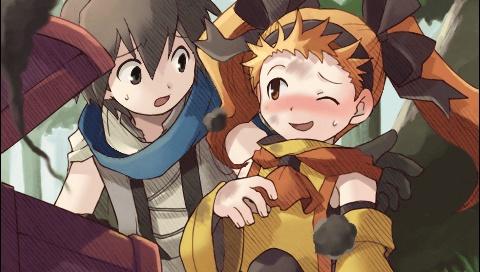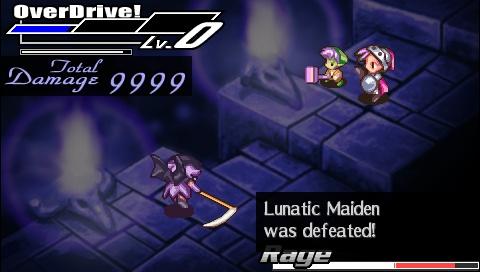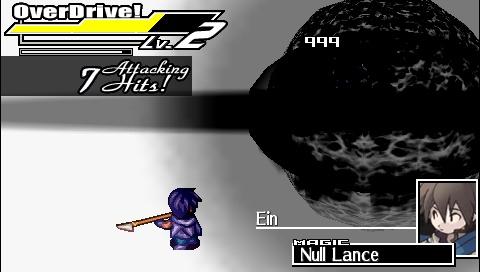Riviera: The Promised Land Review
Riviera: The Promised Land began its life as a Japanese RPG that was largely ignored, lost in the sea of hundreds of other games that had come before it and after it on the Nintendo and Sony handheld platforms. However, thanks to Atlus and their undying devotion to even the most obscure of RPGs, have released the game not only on the Gameboy Advance, but have even brought an enhanced remake to Sony's PlayStation Portable. Because of that, it has fortunately grown to become a sleeper hit among RPG fans.

The story of Riviera starts out as Ein, a young and inexperienced wingless angel, is sent on an important mission by the Gods of Aesgard to activate the infamous Retribution, an unfathomable power that will cleanse the world of Riviera and its demon inhabitants. A mysterious Magi, Hector, whom is a servant of the gods, has administered these orders to Ein to activate the Retribution. Ein journeys to the so-called “Heaven’s Gate” along with his pet familiar, Rose, and his somber and unfriendly companion, Ledah. This is only the beginning of an epic tale of angels and demons, as Ein will soon change the history of Riviera itself.
Riviera: The Promised Land involves a rather convoluted story for such a simple game. Most of the story elements in this game come from the interesting character development told through compelling dialogue between the likable characters. In these conversations, Ein has the ability to sway the moods and actions of his female companions along his journey in what can be called a dating simulation – developing relationships with the girl that strikes your fancy the most.
Riviera also finds itself handling fairly adult themes for an RPG; these range from the romance and betrayal to downright slaughter and murder (which brings to mind the Shin Megami Tensei series), which is noted by its Teen rating on the box. This is definitely not meant to be a game for the kiddies.

The real innovative factor about Riviera is the gameplay itself. Rather than using the typical movement style of RPGs, Riviera uses a sort of early 90's adventure-like style. Players go from room to room by pressing a direction on the D-pad. At each room, players have the ability to switch into a sort of "Look" mode by pressing A. This Look mode allows them to examine various parts of the room’s surroundings including hidden passages, treasure chests, etc.
To look at these objects though, the player requires Trigger Points or TPs. Trigger Points are obtained by receiving exceptional rankings in combat. This element encourages players to try and win each combat in the most efficient manner for maximum TP. By examining the different objects of interest, the player will gain attributes, items and even new dialogue. This also adds an excellent factor of replay -- it is implausible that any player will be able to examine every object on their first playthrough (or even their second) due to the lack of available TP, especially during the earlier parts of the game.
The combat system of Riviera, though traditional at heart, supplements the game in a fascinating way. Riviera is identical to most other RPGS with exception to a few important factors. One main dynamic is the idea that characters can only bring in 4 items to each combat. Before every combat, the player is prompted with a screen where they most select these items. This adds a certain tactical element to the game as the player most choose very carefully about the battle ahead.

Another notable element of Riviera is how the characters gain experience. Rather than gaining XP by winning battles, players gain abilities and skills by using the items in their inventory. To balance the game though (so the character doesn’t constantly break his items from constant use), a practice battle system is included. In this system, the players are given combatants to defeat yet they receive no penalty from using items. That means unlimited uses of any item in practice battle. Though this system may not sound too fitting, it plays out in a brilliant manner.
As I said, Riviera provides some incentive to replay this epic, with multiple endings and various things that the player may have surely missed. Players will also find themselves with a sort of reluctance to return to Riviera though. It can become quite repetitive near the ending, and after playing the adventure for the some 20-30 hours of gameplay, players will be unwilling to journey once again in Riviera. To some though, the idea of the multiple endings does provide incentive enough to return.
Riviera also has excellent visuals for a game that began its life on the Gameboy Advance before being ported to the Sony PSP. Vibrant colors exist throughout your adventure. The soundtrack is also excellent along with the voice acting (though in small sections), a rarity of GBA games.
Riviera also has excellent visuals for a game that began its life on the Gameboy Advance before being ported to the Sony PSP. Vibrant colors exist throughout your adventure. The soundtrack is also excellent along with the voice acting (though in small sections), a rarity of GBA games.

One questionable element of the graphics is the usage of colors. At certain points in the game, you will find even the most dire settings seem all too welcoming. To produce a more ambient atmosphere, the artists could have chosen a slightly darker design in these areas. I must say though that the slick animations and enticing Japanese Anime-inspired artwork certainly gets the job done.
As you can see, I enjoyed Riviera quite a lot. The compelling (and mature) story elements are a rarity in the handheld RPG genre, a break away from all the other hero-saves-the-world stories that have been a staple for the market. Although the action can be pretty linear for the most part, the strong execution of the art design combat, and lengthy play time make up for that in spades. If you are still able to find Riviera at your local gaming outlet, do yourself a favor and pick this title up!
As a side note, I wouldn't say there is a big difference between the GBA and PSP versions of this title, so you can't reall go wrong with either one in this case, but the 16:9 widescreen on the PSP definitely gives you a better view of the action.